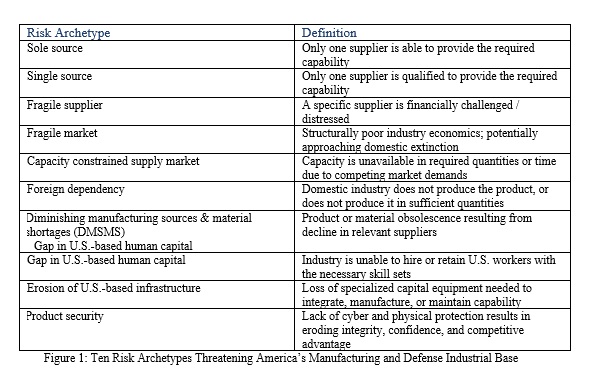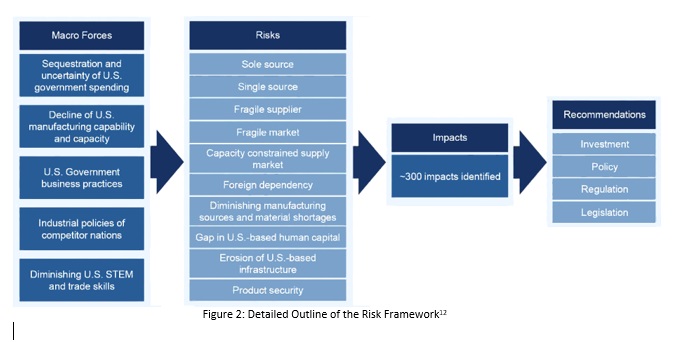ELVERT L. GARDNER
July 2, 2019
I. INTRODUCTION
In this essay, Elvert Gardner describes NDU’s inaugural NC3 study course on the readiness of the industrial base to support US NC3 modernization and supply chain risks that may impede DoD’s ability to purchase technology in a timely and affordable manner.
Colonel Elvert Gardner is an assistant professor at The Dwight D. Eisenhower School for National Security Strategy and Resourcing, National Defense University, where he directs the inaugural Nuclear Command, Control, and Communications (NC3) Industry Study course.
Acknowledgments: The workshop was funded by the John D. and Catherine T. MacArthur Foundation.
This report is published simultaneously here by Technology for Global Security and here by Nautilus Institute and is published under a 4.0 International Creative Commons License the terms of which are found here.
The views expressed in this report do not necessarily reflect the official policy or position of the Nautilus Institute. Readers should note that Nautilus seeks a diversity of views and opinions on significant topics in order to identify common ground.
The views expressed in this report do not necessarily reflect the official policy or position of the Nautilus Institute. Readers should note that Nautilus seeks a diversity of views and opinions on significant topics in order to identify common ground.
Banner image is by Lauren Hostetter of Heyhoss Design
II. NAPSNET SPECIAL REPORT BY ELVERT L. GARDNER
AN EXAMINATION OF THE US NC3 INDUSTRIAL AND INNOVATION BASE
July 2, 2019
Summary
The Nuclear Posture Review highlights the plan for an enormous overhaul of the entire nuclear enterprise – including the NC3 architecture. Some cost estimates for this effort exceed 1.2 trillion US dollars. One important contextual note is this massive modernization effort comes at a time when the nuclear enterprise has been underfunded for over two decades. The importance of this protracted underfunding is there are unintended consequences and implications for the national security innovation base and the national security industrial base that will be charged with the research, development, testing, evaluation, fielding, and sustainment of these modern NC3 systems. Many discussions on the modernization of the NC3 architecture do not discuss the industrial base. However, the Dwight D. Eisenhower School for National Security Strategy and Resourcing at National Defense University is specifically charged with examining the defense industrial base and its ability to help the Department of Defense (DoD) maintain a continuing strategic advantage in critical mission areas such as nuclear command, control, and communication. The NC3 industry study, which is currently in its first year of execution, will examine this critical area and identify the readiness of the industrial base to meet the demand of DoD. Where applicable, policy prescriptions will be offered to help build greater efficiencies with the NC3 industry.
Introduction
Eisenhower School Mission and Industry Study Program Pedagogy
The mission of National Defense University’s Dwight D. Eisenhower School (ES) for National Security and Resource Strategy is to “Prepare select military officers and civilians for strategic leadership and success in developing national security strategy and in evaluating, marshaling, and managing resources in the execution of that strategy.”[1] The hallmark of the ES curriculum is the Industry Study Program (ISP). The ISP provides an in-depth study of the national and global resource base by combining lectures, seminar discussions, field studies, post-visit synthesis, and individual research presented in a variety of written and oral reports.
Origins of the NC3 Industry Study Program
In the aftermath of the release of the 2018 National Defense Strategy extensive dialogue ensued at National Defense University and the Pentagon. One overriding theme that emerged from these discussions was the need to identify the key mission areas where America must maintain a ‘continuing strategic advantage’ against the backdrop of emerging threats and great power competition. The ES’s ISP was viewed as an ideal forum for examining the various key mission areas, which included nuclear command and control (NC2). The initial course design was further refined to explore nuclear command, control, and communications (NC3). This decision was due in part to the need to draw a tighter connection between the mission area/function (i.e., NC2) and the national security industrial base and the national security innovation base that delivers the capabilities that enable NC2. This decision also adheres to National Defense Authorization Act language, which stipulates the requirement to train and educate officers on NC3.[2]
The NC3 industry study is comprised of 16 students from the Army, Air Force, Navy, and Marines, as well as the Departments of State, Energy, and Homeland Security. The students will leverage other ES courses in Business Economics, Acquisition and Innovation, and Industry Analysis. These courses will enable the students to examine the NC3 industry using a structure-conduct-performance evaluation methodology. Ultimately, students will apply the theories, frameworks, models, and methodologies of industry analysis to evaluate the NC3 industry’s strategies, practices, perspectives, capabilities, and limitations.[3] After completion of this rigorous industry examination, students will develop politically and resource-informed policy prescriptions to improve U.S. national security and economic interests.[4] These findings, along with their corresponding observations, will be assembled into a group paper and presented as an interactive outbrief to senior leaders and key stakeholders in the NC3 community.
NC3 Definition
NC3 is a large and complex system of numerous land, air, and space-based components used to assure connectivity between the president and nuclear forces.[5] The NC3 industry is comprised of U.S. manufacturing industry establishments primarily engaged in one or more of the following: (1) manufacturing or assembling equipment used primarily for NC3 purposes; (2) acquisition and sustainment of NC3 systems; (3) NC3 conversion (i.e., major modifications to NC3 systems); and (4) research, development, testing, and engineering of next-generation NC3 innovation and technologies.
Initial Observations of the NC3 Enterprise
Although the NC3 industry study is in its infancy, a number of observations have emerged as part of the initial investigation into the area. Based on preliminary discussions with subject matter experts, coupled with information acquired during field visits, some of the major considerations confronting the NC3 industry include human capital considerations, cybersecurity implications on manufacturing, supply chain risk management, corporate planning and management strategies, sources of innovation, and government-to-corporate-to-innovation base organizational relationships. From this list of considerations the following foundational questions have been identified as drivers for the NC3 industry study:
- Why is this industry important to national security?
- Is this industry properly structured to promote innovation?
- What are the existing and emerging patterns of governance for NC3 and what are the implications for U.S. national security (including corporate & business strategies)?
- What are the ongoing/upcoming nuclear enterprise modernization efforts impacting NC3 in the short, mid, and long term?
- In the current construct, is industry poised to meet the NC3 modernization needs of DoD on the required timeline?
- Besides business, what other institutions contribute to the NC3 enterprise and how?
- What government (direct and indirect) subsidies accrue to commercial NC3 manufacturers and their effects on international competition and high-technology trade?
- What are the implications of the oligopolistic nature of the NC3 manufacturing base? What are the risks to national security? What are the hedging mechanisms?
- What are the challenges confronting the design and development of the NC3 “to-be” architecture?
Of the list of questions above, the two questions highlighted in bold are best suited for further discussion in the context of this initial writing on the NC3 industry study. That discussion is further guided by thinking critically on these issues and distilling them down into working hypotheses, corresponding implications, followed by some indication of the strategic/policy path forward.
Working Hypotheses
- What are the ongoing/upcoming nuclear enterprise modernization efforts impacting NC3 in the short, mid, and long term?
- Working hypothesis: Given the extended period of the DoD’s underfunding the nuclear enterprise over the past 25 years, it can be hypothesized that the current $400B modernization effort is late to need.
- Implications: The implications of the protracted period of underfunding the nuclear enterprise is clearly articulated in the 2018 Nuclear posture Review, which stated, “While once state-of-the-art, the NC3 system is now subject to challenges from both aging system components and new, growing 21st century ”[6] As a result, many NC3 systems must now be replaced quickly to preclude or recover from system failures and to outpace advancing threat capabilities.
- Discussion: There are numerous NC3 modernization efforts ongoing or planned in the near term. As of 2015, the US Defense Department had at least nine major NC3 upgrades underway as part of its overall NC3 modernization program. These are as follows:
- Minuteman Minimum Essential Emergency Communications Network (MEECN) Program Upgrade
- Family of Beyond-Line-Of-Sight Terminals (FAB-T)
- Presidential National Voice Conferencing (PNVC)
- Multi-Role Tactical Common Data Link
- Phoenix Air-to-Ground Communications Network (PAGN)
- E-4B Low Frequency Transmit System
- B-2 Common Very Low Frequency Receiver (CVR Inc1)
- E-6B service life extension and Airborne Launch Control System replacement programs
- Global Aircrew Strategic Network Terminal[7]
Anecdotally, numerous NC3 practitioners have argued that some of these modernization efforts are late to need. This imperative suggests industry and technology now need to move at the speed of need. The speed of need may not necessarily align with industry’s capacity to design and field the next generation of NC3 systems. Furthermore, care must be taken to ensure the decision addresses the immediate needs that are compatible with the decisions and systems required in the mid and long term. Ultimately, the numerous sustainment and modernization efforts, spread across various contracts, will require an inordinate level of integration and synchronization to ensure the overall architecture remains effective as it is transformed into a more modern system.
- In the current construct, is industry poised to meet the NC3 modernization needs of DoD on the required timeline?
- Working Hypothesis: Industry will be challenged to meet the needs of DoD within their prescribed cost, schedule, and performance criteria. This is, in part, a by-product of the oligopolistic[8] structure of the industry. Secondarily, industry will experience challenges in meeting the needs of DoD as a result of the protracted underfunding of the nuclear enterprise.
- Implication and possible policy prescriptions: If this hypothesis is true, modernization programs will be characterized patterns of delayed projects and cost overruns. The resulting implication would be an increasingly fragile NC3 architecture. Another potential implication will be a suboptimal level of innovation required to maintain a continuing strategic advantage. This point is emphasized in a response report on Assessing and Strengthening the Manufacturing and Defense Industrial Base and Supply Resiliency.[9]
- Discussion: The NC3 industrial base has a limited number of producers. This reduces competition, leads to challenges in cost structure, and hinders innovation. In short, there is risk inherent assumed by DoD based on the current structure of the NC3 industrial base. The compressed nature of the NC3 industry produces numerous occasions where DoD demands can only be supplied by sole source and single source suppliers. This condition is clearly delineated among the list of ten risk factors that threaten America’s industrial base.[10] By definition, sole source and single source contracts constitute the opportunity for single point of failure.
There is some anecdotal as well as some historical evidence to support some of the challenges experienced in fielding the FAB-T system and the Global Aircrew Strategic Network Terminal (ASNT) system are at least indirectly resultants of the compressed structure of the NC3 industry. This will be a specific point of exploration during the NC3 industry study as the FAB-T and Global ASNT programs are deemed ideal case studies for understanding how the current structure of the industry is impacting the conduct and performance of the industry.
Another consideration is that a limited number of suppliers can adversely impact capacity – particularly surge capacity. More investigation is required here during the NC3 course to identify specific examples of how this issue may be manifesting within the NC3 industry.
The strategic importance of maintaining a secure, reliable, and resilient ability to conduct nuclear command and control demands policy and/or market-driven measures to mitigate this vulnerability. One such measure may be government intervention such as the recent announcement on how the government will offer $250M in cash support to bomb making companies.[11] This action is part of a larger effort to strengthen the broader defense industrial base and may have merit as a tool that can be leveraged for the NC3 industry.

The second component of the working hypothesis states that industry may also be challenged to meet the NC3 modernization needs of DoD, in part, as a result of the protracted dearth of funding for this mission area.
Generally speaking, fiscal uncertainty has an adverse impact on industry. Initial discussions with companies operating in the NC3 industry have confirmed that forecasting their operations is difficult given the uncertainty of government spending. For some of these firms, the result of protracted underfunding in this mission area, coupled with general fiscal uncertainty, has negatively impacted their human capital. Specifically, the ability to attract, develop, and retain talent has been cited as difficult in an uncertain environment where systems are built once every 25 years.
A side effect of the fiscal uncertainty is the volatility introduced into acquisition programs that require a steady, long-term funding stream. Industry has revealed that the resulting perturbation in programs is a considerable detractor for working with government. This is another area of exploration for the NC3 industry study. Students will spend time with industry leadership understanding their business practices and how they perceive their relationship with government. The outcome of these discussions will inform the policy recommendations that students offer as potential remedies for the existing govern-to-industry relationship.
The chart below identifies several macro forces, which introduce risk into any industrial base. Initial consultation with industry has revealed that in addition to the fiscal uncertainty issue mentioned above, there may be other factors that are also applicable across the Nc3 enterprise. Additional examination is required to gain sufficient insight of how this is occurring and what policy prescriptions may be applicable.

Conclusion
The NC3 industry study will more closely examine many of the initial findings indicated in this paper. Care will be taken to assess the structure of the industry and how that influences the conduct and performance of that industry. At the conclusion of this semester, the findings and recommendations will be presented to key stakeholders in the form of an interactive outbrief. This outbrief will include representatives from industry, the national innovation base, and government. Other opportunities to share the results with the community of interest will also be developed. Ultimately, the NC3 mission area is critical national security. This academic endeavor will provide an important and unique perspective that provides insight into how the NC3 industrial base operates and what can be done to obtain a higher level of efficiency and effectiveness across the entire NC3 enterprise.
III. ENDNOTES
[1] National Defense University Homepage, accessed January 14, 2019, https://es.ndu.edu/About/Mission/.
[2] FY19 NDAA sec. 1668. Plan to train officers in nuclear command, control, and communications.
[3] Officer Professional Military Education Policy (OPMEP). 1993. CJCSI: 1800.01A, B, C, D. [Washington, D.C.] : Joint Chiefs of Staff, [1993]-. https://nduezproxy.idm.oclc.org/login?url=http://search.ebscohost.com/login.aspx?direct=true&db=cat04199a&AN=ndu.224928&site=eds-live&scope=site
[4] Ibid.
[5] GAO, Nuclear Command, Control, and Communications: Update on DOD’s Modernization, GAO-15-584R, June 2015 at: http://www.gao.gov/products/GAO-15-584R
[6] Nuclear Posture Review. 2018. Washington, D.C. : Office of Assistant Secretary of Defense, 2018, pg XIII.
[7] Admiral Cecil Haney, “House Armed Services Committee Testimony,” February 26, 2015, Washington DC, at: https://www.stratcom.mil/speeches/2015/132/House_Armed_Services_Committee_Testimony/
and GAO, Nuclear Command, Control, and Communications: Update on DOD’s Modernization, GAO-15-584R, June 2015 at: http://www.gao.gov/products/GAO-15-584R
[8] Oligopoly is defined as a state of limited competition, in which a market is shared by a number of producers.
[9] https://media.defense.gov/2018/Oct/05/2002048904/-1/-1/1/ASSESSING-AND-STRENGTHENING-THE-MANUFACTURING-AND-DEFENSE-INDUSTRIAL-BASE-AND-SUPPLY-CHAIN-RESILIENCY.PDF
[10] Ibid, pg 46.
[11] https://www.defensenews.com/congress/2019/01/16/trump-to-use-federal-funds-to-prop-up-us-bomb-makers/?utm_source=Sailthru&utm_medium=email&utm_campaign=Breaking%20News%201.16.19&utm_term=Editorial%20-%20Breaking%20News
[12] Assessing and Strengthening the Manufacturing and Defense Industrial Base and Supply Chain Resiliency of the United States, pg 13.
IV. NAUTILUS INVITES YOUR RESPONSE
The Nautilus Asia Peace and Security Network invites your responses to this report. Please send responses to: nautilus@nautilus.org. Responses will be considered for redistribution to the network only if they include the author’s name, affiliation, and explicit consent


